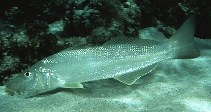http://www.fishbase.org/Summary/speciesSummary.php?genusname=Sillago&speciesname=ciliata ---> http://52.67.158.155/Summary/speciesSummary.php?genusname=Sillago&speciesname=ciliata
http://52.67.158.155/Summary/speciesSummary.php?genusname=Sillago&speciesname=ciliata ---> https://fishbase.net.br/Summary/speciesSummary.php?genusname=Sillago&speciesname=ciliata
https://fishbase.net.br/Summary/speciesSummary.php?genusname=Sillago&speciesname=ciliata ---> https://fishbase.net.br/summary/Sillago-ciliata.html
Sillago ciliata, Sand sillago : fisheries, aquaculture, gamefish, aquarium

You can
sponsor
this page
Common name (e.g. trout)
Genus + Species (e.g. Gadus morhua)
-

-
About this page
-
Languages
-
User feedbacks
-
Citation
-
Uploads
-
Related species
-


 Sand sillago
Add your observation in
Fish Watcher
Upload your
photos
and
videos
Sand sillago
Add your observation in
Fish Watcher
Upload your
photos
and
videos
Pictures
|
Videos |
Google image
 Sillago ciliata
Sillago ciliata
Picture by
Randall, J.E.
Teleostei (teleosts) >
Eupercaria/misc
(Various families in series Eupercaria) >
Sillaginidae
(Smelt-whitings)
Etymology:
Sillago:
From a locality in Australia
.
More on author:
Cuvier
.
Environment: milieu / climate zone / depth range / distribution range
Ecology
Marine; brackish; demersal; non-migratory; depth range 0 - 46 m (Ref.
6335
), usually 20 - 22 m. Tropical; 9°S - 45°S, 142°E - 170°E (Ref.
6205
)
Western Pacific: east coast of Australia from Cape York (rare) and the Great Barrier Reef, Queensland to eastern Victoria, Ulverstone on northeast coast of Tasmania; Lord Howe Island, New Caledonia, Woodlark Islands, and Papua New Guinea. Bleeker's records (Ref.
1502
,
1843
) from Batavia and Java were in error (Ref.
4899
).
Length at first maturity / Size / Weight / Age
Maturity: L
m
24.0
range ? - ? cm
Max length : 51.0 cm TL male/unsexed; (Ref.
6205
); max. published weight: 1.4 kg (Ref.
6390
); max. reported age: 22 years (Ref.
1254
)
Dorsal
spines
(total): 12;
Dorsal
soft rays
(total): 16-18;
Anal
spines
: 2;
Anal
soft rays
: 15 - 17;
Vertebrae
: 32 - 34. The shape of the swim bladder is not distinguishable from that of
S. analis
. Anterior part of the swim bladder with rudimentary tubules projecting anteriorly and a series laterally that diminish in size and become sawtooth-like posteriorly. The coloration of adult specimens is uniform, without darker bars or blotches. A dark spot is present at the base of the pectoral fin in younger individuals.
An onshore schooling species occurring on coastal beaches, sandbars, and surf zones as well as open bays, estuaries, coastal lakes (Ref.
6205
), and rivers as far as tidal limits (Ref.
6390
). Keep away from shore when older. Live almost exclusively on sandy ground. Juveniles and adolescents are abundant in shallow waters of rivers and creeks, over seagrass beds and in mangroves (Ref.
6223
), although they tend to move into deeper water as they grow older (Ref.
6390
). Larvae are present in river mouths and mangrove areas most of the year (Ref.
27634
). Oviparous (Ref.
205
). Feed mostly on polychaetes and crustaceans. Also caught using tunnel nets (Ref.
6205
).
Sand whiting probably spawn twice each season (Ref.
1254
,
27633
). Spawning occurs at peak high tide, at night, and 1-2 days before the new moon (Ref.
6390
).
McKay, R.J.
, 1992. FAO Species Catalogue. Vol. 14. Sillaginid fishes of the world (family Sillaginidae). An annotated and illustrated catalogue of the sillago, smelt or Indo-Pacific whiting species known to date. Rome: FAO. FAO Fish. Synop. 125(14):87p. (Ref.
6205
)
IUCN Red List Status (Ref.
130435
)
Least Concern (LC)
; Date assessed:
05 March 2015
CITES
Not Evaluated
Not Evaluated
Threat to humans
Harmless
Human uses
Fisheries: highly commercial; aquaculture: experimental; gamefish: yes; aquarium: public aquariums
FAO - Publication:
search
|
FishSource
|
More information
Countries
FAO areas
Ecosystems
Occurrences
Introductions
Stocks
Ecology
Diet
Food items
Food consumption
Ration
Common names
Synonyms
Metabolism
Predators
Ecotoxicology
Reproduction
Maturity
Spawning
Spawning aggregation
Fecundity
Eggs
Egg development
Age/Size
Growth
Length-weight
Length-length
Length-frequencies
Morphometrics
Morphology
Larvae
Larval dynamics
Recruitment
Abundance
BRUVS
References
Aquaculture
Aquaculture profile
Strains
Genetics
Electrophoreses
Heritability
Diseases
Processing
Nutrients
Mass conversion
Collaborators
Pictures
Stamps, Coins Misc.
Sounds
Ciguatera
Speed
Swim. type
Gill area
Otoliths
Brains
Vision
Tools
Bio-Quiz
|
E-book
|
Field guide
|
Identification keys
|
Length-frequency wizard
|
Life-history tool
|
Point map
|
Classification Tree
|
Catch-MSY
|
Special reports
Check for Aquarium maintenance
|
Check for Species Fact Sheets
|
Check for Aquaculture Fact Sheets
Download XML
Summary page
|
Point data
|
Common names
|
Photos
Internet sources
AFORO (otoliths)
|
Aquatic Commons
|
BHL
|
Cloffa
|
BOLDSystems
|
Websites from users
|
Check FishWatcher
|
CISTI
|
Catalog of Fishes
:
genus
,
species
|
DiscoverLife
|
ECOTOX
| FAO - Publication:
search
|
Faunafri
| Fishipedia |
Fishtrace
| GenBank:
genome
,
nucleotide
|
GloBI
|
Google Books
|
Google Scholar
|
Google
| IGFA World Record |
MitoFish
|
Otolith Atlas of Taiwan Fishes
|
PubMed
| Reef Life Survey | Socotra Atlas |
Tree of Life
| Wikipedia:
Go
,
Search
| World Records Freshwater Fishing |
Zoobank
|
Zoological Record
Estimates based on models
Preferred temperature (Ref.
123201
): 21.2 - 27.4, mean 25.4 °C (based on 182 cells).
Phylogenetic diversity index (Ref.
82804
): PD
50
= 0.5000 [Uniqueness, from 0.5 = low to 2.0 = high].
Bayesian length-weight: a=0.00617 (0.00340 - 0.01119), b=3.13 (2.96 - 3.30), in cm total length, based on LWR estimates for this species & (Sub)family-body (Ref.
93245
).
Trophic level (Ref.
69278
): 3.2 ±0.2 se; based on diet studies.
Resilience (Ref.
120179
): Medium, minimum population doubling time 1.4 - 4.4 years (K=0.39; tm=2-3; tmax=22; Fec=31,000).
Fishing Vulnerability (Ref.
59153
): Low to moderate vulnerability (28 of 100).
Price category (Ref.
80766
):
Very high
.
Nutrients (Ref.
124155
): Calcium = 348 [82, 932] mg/100g; Iron = 1.22 [0.47, 3.13] mg/100g; Protein = 20.8 [18.0, 23.0] %; Omega3 = 0.221 [0.099, 0.482] g/100g; Selenium = 43.2 [14.8, 143.3] μg/100g; VitaminA = 27.7 [5.9, 122.3] μg/100g; Zinc = 1.25 [0.65, 3.06] mg/100g (wet weight);
Back to Search
Random Species
Back to Top
Accessed through:
Not available
FishBase mirror site :
Laguna, Philippines
Page last modified by :
mrius-barile
|